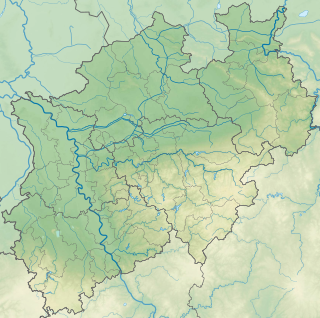Niederbergisch-Märkisches hill country
| Niederbergisch-Märkisches hill country | |||
|---|---|---|---|
| Systematics according to | Handbook of the natural spatial structure of Germany | ||
| Greater region 1st order | Low mountain range threshold | ||
| Greater region 2nd order | Rhenish Slate Mountains | ||
| Main unit group | 33 → Süderbergland |
||
| About main unit | 337 → Bergisch-Sauerland lowlands |
||
| Natural space |
337 1 → Niederbergisch-Märkisches hill country |
||
| Geographical location | |||
| Coordinates | 51 ° 23 '42 " N , 7 ° 24' 12" E | ||
|
|||
| state | North Rhine-Westphalia | ||
| Country | Germany | ||
With low Bergisch-Märkische hills of the northwestern part of the right bank Schiefergebirges in is Niederbergisches country and in the northwest of the Lower Bergisch country called. It extends from the Ruhr valley along with the right edge heights between below Wetters and Mülheim in the north to the Wupper valley near Wuppertal in the south; to the west it borders on the Bergische Heideterrasse , which already leads into the Cologne Bay . To the right of the Ruhr, the Ardey Mountains are also included in the extreme northeast .
The name comes from the handbook of the natural spatial structure of Germany , which identifies the landscape as the main natural spatial unit within the main unit group 33 Süderbergland . In its 4./5. Delivery from 1957, mapped by the map 1: 1,000,000 from 1954, this main unit, excluding the Ardey Mountains, still bore the code number 337 and was referred to as Niederbergisches Hügelland (Bergisches Unterland) . Since the more recent mapping from 1960, the code number has been changed to 337 1 and the demarcation changed accordingly. The extension to include the Ardey Mountains is not yet shown in the Düsseldorf sheet of 1963, but it is in the Arnsberg sheet of 1969, which divides the extreme east of the main unit.
The Niederbergisch-Märkisches Hügelland corresponds in parts to the cultural landscape of the Niederbergisch-Märkisches Land , which however does not include the Ruhr valley (or only that below Witten ) and extends south to Remscheid and Solingen .
Location and limits
The Niederbergisch-Märkisch hill country is limited by the following places:
- Mülheim in the northwest
- Dortmund and Schwerte , each already outside, in the northeast
- Hagen , just outside, in the east
- Wuppertal in the south
- Düsseldorf , outside, in the west
In addition to the Ruhr in the north and a small section of the Wupper in the south, the valley of the Ennepe from Gevelsberg together with the mouth of the Volme border valley in the east, but is already outside the main unit. A little further away and separated by the Heideterrasen as an intermediate stage, the Rhine forms a western border river.
Natural structure
The Niederbergisch-Märkisch hill country is structured as follows:
-
(to 33 Süderbergland )
-
(to 337 Bergisch-Sauerland Lowlands )
- 337 1 Niederbergisch-Märkisches hill country
- 337 1 .0 Niederberg hill terraces
- 337 1 .00 Mettmann loess terraces
- 337 1 .01 Heiligenhauser Terraces
- 337 1 .03 Selbecker Terrassenland
- 337 1 .1 Bergisch-Märkisches hill country
- 337 1 .10 Velbert ridge
- 337 1 .11 Vossnacken
- 337 1 .12 Hardenberger hill country
- 337 1 .13 Märkisches layered rib land
- 337 1 .14 Ruhr stratified rib land
- 337 1 .15 Hasslinghauser Ridge
- 337 1 .16 Dornaper limestone area
- 337 1 .17 Wülfrath limestone area
- 337 1 .18 Dusseldorf hill country
- 337 1 2 Ruhr valley
- 337 1 3 Wuppertal Valley
- 337 1 .30 Linderhauser Senke
- 337 1 .31 Schwelmer mass limestone valley
- 337 1 .32 Linderhauser back
- 337 1 .33 Limestone basin in Barmer
- 337 1 .34 Hardt slate back
- 337 1 .35 Elberfeld limestone sink
- 337 1 .36 Nützenberg crossbar
- 337 1 .37 Sonnborn limestone area
- 337 1 .38 Vohwinkel depression
- 337 1 4 Ardeypforte
- 337 1 5 Ardey
- 337 1 50 Ardeyhöhe
- 337 1 51 South Gardey walls
- 337 1 .0 Niederberg hill terraces
- 337 1 Niederbergisch-Märkisches hill country
-
(to 337 Bergisch-Sauerland Lowlands )
Individual evidence
- ^ Emil Meynen , Josef Schmithüsen : Handbook of the natural spatial structure of Germany . Federal Institute for Regional Studies, Remagen / Bad Godesberg 1953–1962 (9 deliveries in 8 books, updated map 1: 1,000,000 with main units 1960).
- ^ A b Karlheinz Paffen, Adolf Schüttler, Heinrich Müller-Miny: Geographical land survey: The natural space units on sheet 108/109 Düsseldorf / Erkelenz. Federal Institute for Regional Studies, Bad Godesberg 1963. → Online map (PDF, 7.3 MB)
- ↑ a b Martin Bürgener: Geographical land survey: The natural space units on sheet 110 Arnsberg. Federal Institute for Regional Studies, Bad Godesberg 1969. → Online map (PDF, 5.7 MB)
- ↑ Cultural landscapes according to LWL with download of the corresponding maps (administrative districts Düsseldorf and Arnsberg, reference number 20)
- ↑ This over-main unit basically only combines two independent main units, which is owed to the fact that the decadal system only allows 10 three-digit numbers between 330 and 339, but the Süderbergland has 12 main units.
